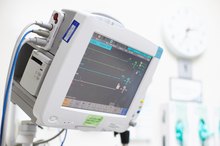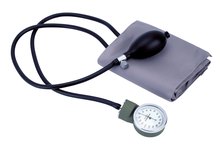How to Read a Fetal Monitor Strip
Continuous Electronic Fetal Monitoring (EFM) is the standard of care in labor and delivery departments of most hospitals. Monitor printouts provide information for professional caregivers but they can also give labor support persons clues on how to help the laboring woman.
Find the Baseline Fetal Heart Rate in the top of the fetal monitor strip. Tracings of the normal fetal heart rate are between 120 and 160. The baseline will be stable with a ten-beat variability, for instance 120 to 130, or 134 to 144.
What Does it Mean to Be 80 Effaced?
Learn More
Find the toco, or uterine contraction tracing, in the bottom half of the strip. The baseline when the woman's abdomen is relaxed will be from zero to 10. The tracing starts to rise when the contraction begins, bell curves to indicate peak tension, and comes back to baseline when the contraction ends.
Ascertain how far apart contractions are and how long they last from the toco tracing. Monitors are set at a rate of either one or three minutes per inch. Unless an intrauterine catheter is used, the tracing will not indicate the force of contractions. Tracings will vary by the size of the woman and placement of the external toco.
Diastolic Blood Pressure During Exercise
Learn More
Watch the pattern of fetal heart rate in relation to contractions. It is fine if fetal heart rate follows a ten-beat variability baseline during labor. The presence of variability is good. A rise in fetal heart rate at the beginning of a contraction is reassuring. Variable decelerations, sudden V-shaped dips below the baseline, may indicate compression of the umbilical cord and a need to change positions. Late decelerations, when the heart rate dips below baseline and only gradually recovers after a contraction, are signs that the unborn is stressed by lack of oxygen. Low heart rates during pushing stage, however, are a normal reaction to head compression and will quickly recover between contractions, which naturally are farther apart then.
Tips
The beginning of a contraction may be seen on the monitor strip prior to the mother being aware of it and may still feel contractions after the monitor indicates they are ended. It can be helpful to give the mother a warning that a contraction has started so she can take a deep cleansing breath before she is caught off guard by pain, and to tell her a contraction is ending so she knows discomfort will not last much longer.
A mother under epidural anesthesia should still breathe slowly and deeply during contractions to oxygenate her baby. The monitor strip can be her connection to the baby's needs through contractions she is otherwise not aware of.
Warnings
Healthcare professionals are required to attend formal training to learn to read Electronic Fetal Monitor strips. This is a matter of public safety. This article in no way substitutes for that type of training.
Related Articles
Tips
- The beginning of a contraction may be seen on the monitor strip prior to the mother being aware of it and may still feel contractions after the monitor indicates they are ended. It can be helpful to give the mother a warning that a contraction has started so she can take a deep cleansing breath before she is caught off guard by pain, and to tell her a contraction is ending so she knows discomfort will not last much longer. A mother under epidural anesthesia should still breathe slowly and deeply during contractions to oxygenate her baby. The monitor strip can be her connection to the baby's needs through contractions she is otherwise not aware of.
Warnings
- Healthcare professionals are required to attend formal training to learn to read Electronic Fetal Monitor strips. This is a matter of public safety. This article in no way substitutes for that type of training.
Writer Bio
Mary Earhart is a registered nurse, a public health nurse and licensed midwife. Her articles have appeared in professional journals and online ezines. She holds a Bachelor of Science in nursing from California State University at Dominguez Hills. She works in a family practice clinic, has a home birth practice and her specialty is perinatal substance abuse.








